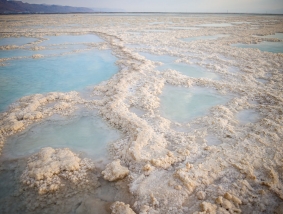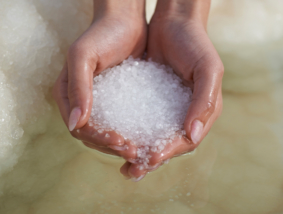No holiday in the Holy Land is complete without a trip to the ancient Dead Sea. From skincare enthusiasts to nature adventurers, from people who need a relief from their skin diseases to religious seekers who believe in the sanctity of the area, the Dead Sea attracts people from all walks of life, from all over the world, any time of the year.
Just a one-hour drive from Jerusalem, the Dead Sea is part of the border between Israel and Jordan. In the center of a valley that nests in high cliffs, it’s surrounded by a stunning landscape that makes for amazing pictures. Located at the lowest point on Earth, the Dead Sea area is so deep that traveling on the road that winds down to its shores can cause your ears to pop the way they pop when you fly. That’s right!
From ancient times to the modern era
The Dead Sea remains from a series of prehistoric lakes that no longer exist. At minus 423 meters below sea level and fed by the Jordan River, it’s a terminal lake with no outflowing waters – meaning, there are no rivers that take water out of the Dead Sea, making it, in fact, a lake and not a sea.
Known in Hebrew as Yam Ha-Melakh (the Sea of Salt), it’s called the Dead Sea in other languages because it was assumed that no living beings could survive in its hypersaline waters. It was only a century ago when biologists discovered Dunaliella Salina – a unique microalga that not only survives but thrives in the Dead Sea thanks to its high carotenoid capacities.
The Dead Sea’s salt content is ten times higher than any other sea. The Mediterranean Sea, for example, has a 3.5% salinity while the Dead Sea has a whopping 34%. Here’s a fun historical fact – the Romans, who ruled the area for a long time, cherished this salt so much that salt became currency. In fact, the English word “salary” comes from the Latin root “sal,” meaning “salt.”

The size and depth of the Dead Sea have changed over time thanks to variations in climate and the impact of humans e.g. building of dams on the Jordan River. Its depth is also not uniform across its seabed – it can go anywhere from ten meters in the southern basin to two hundred meters in the northern basin.
Health benefits of the Dead Sea
The Dead Sea is unique both in composition and in concentration – featuring high amounts of minerals such as magnesium, sodium, and calcium, making it a natural source of healing for the skin, the body, and the soul. In total, there are twenty-one minerals, the combination of twelve of which aren’t found anywhere else.
Many people who suffer from chronic skin, respiratory and joint conditions come to the Dead Sea year after year. Many doctors send their patients with common skin conditions such as psoriasis, atopic dermatitis and vitiligo to the region as the Dead Sea provides a natural treatment option without side effects that come from drug use. The region has pollen-free air with high oxygen content, high barometric pressure and low humidity which help soothe the symptoms of asthma, cystic fibrosis, and some lung diseases.
Young or old, men or women, healthy or health-seeking, all visitors benefit from the Dead Sea’s exceptional solar, air and mineral properties regardless of the season. They love to float in its salty waters and some also cover their bodies with the mineral-rich mud in order to experience firsthand the oldest natural spa on Earth. Every second of it is a pleasure not found anywhere else.
You might also like

Cleopatra’s Beauty Secret is Hidden in the Dead Sea
March 12, 2020
Is salt from the Dead Sea good for your skin?
July 30, 2019




